HISTORY OF ARBORWALL
A little over four decades ago, three men embarked on a partnership called Katahdin Forest Products to pool their skills and start to build cedar log homes. Forty years later, the mill that produced a single log home a year has grown and evolved into to one that could manufacture twice that number of homes in a single day - Katahdin Cedar Log Homes. In that 40th anniversary year, work began on an idea that would become Arborwall solid cedar homes. The new division would gather all the innovation and expertise that had made Katahdin successful in the log home industry and create a new way to define homes.
The story of how that happened is a study in perseverance, hard work and innovation set in the backdrop of Aroostook County in northern Maine.
Katahdin Cedar Log Homes started with three men, Foster "Curly" Gordon, Fred McCormick and Wayne Farrar. These friends decided to pool their talents and start their own cedar sawmill to produce fencing and log homes. The first four years, the fledgling company produced a log home each year. The homes were labor intensive: hand-peeled, shaped by hand using a two-handled draw shave, and notched and cut to fit the house plan. The trio persevered through the 70s with their log home dream and kept producing cedar fencing to survive.
In 1977, a relative boom year, David Gordon, Foster's son, began working at the mill full-time. It was about that time that Katahdin began to recognize that cedar's naturally low moisture content would enable the application of insulation to the interior of the solid cedar walls, without the shrinkage problems that other tree species had. Because they were milling the cedar themselves, the insulation "package" provided a tongue-in-groove cedar paneling to maintain the look and feel of a log home interior. And, if a customer preferred, some walls might be finished with traditional wallboard.
The 80s were witness to steady growth into a very nice business. However, everything for the log homes continued to be peeled and shaved by hand with a draw knife by about 20 employees, shipping 2-3 homes per week.
In 1989, a state-of-the-art industrial planer arrived in Oakfield and enabled logstock production to increase exponentially. The planer allowed Katahdin to prepare log stock with tongue and groove for 8-9 homes a day.
Around this time Katahdin started to look at ways to decrease waste and utilize more of the cedar logs that were coming into mill production. At this time, the post and rail mill was constructed to peel the tops of trees down to a two-inch diameter to incorporate into post and rails for stairs and decks. It also marked the inception of Cedar Ideas, another green way to utilize more and more of the cedar trees.
It was also during this timeframe that David Gordon started to shoulder more responsibility in the company, with nearly complete direction of the manufacturing by 1995.
With the influx of the new generation and expanding revenues, the early 2000s marked a turn toward more automation and computer-based efficiencies. The house manufacturing line, which was developed and put online in 2005, took the log home design process into the digital age. The house line's ability to transform computer-assisted designs (CAD) of log homes into complete shaped, cut and bar-coded logs efficiently and accurately shifted Katahdin's production ability from a handful of homes in a week to two homes in a single day.
A year later another cost-efficiency was instituted when Gordon installed an industrial biomass boiler. The boiler provides steam heat for the mills and drying logs by burning the sawdust and small scraps that were being trucked to a landfill. The boiler, too, was computer operated and allowed the mills to eliminate 90 percent of fuel oil consumption.
Like many enterprises, Katahdin also benefited from a certain amount of good fortune. In 2006, David was approached by producers of ABC's Extreme Makeover: Home Edition. The producers challenged him to design and build a brand new Katahdin Cedar Log Home for a Wells family who had come upon hard times. They accepted the invitation, and over the following months, every employee and department contributed to making the program a success. The program cemented Katahdin's national and international presence in a single two-hour timeframe.
Ultimately, Katahdin recognized that the cedar homes they were constructing could be produced in a more refined way - maintaining the benefits of solid cedar walls while capturing a unique blend of contemporary and rustic design. The evolution into Arborwall solid cedar homes was a natural progression.
